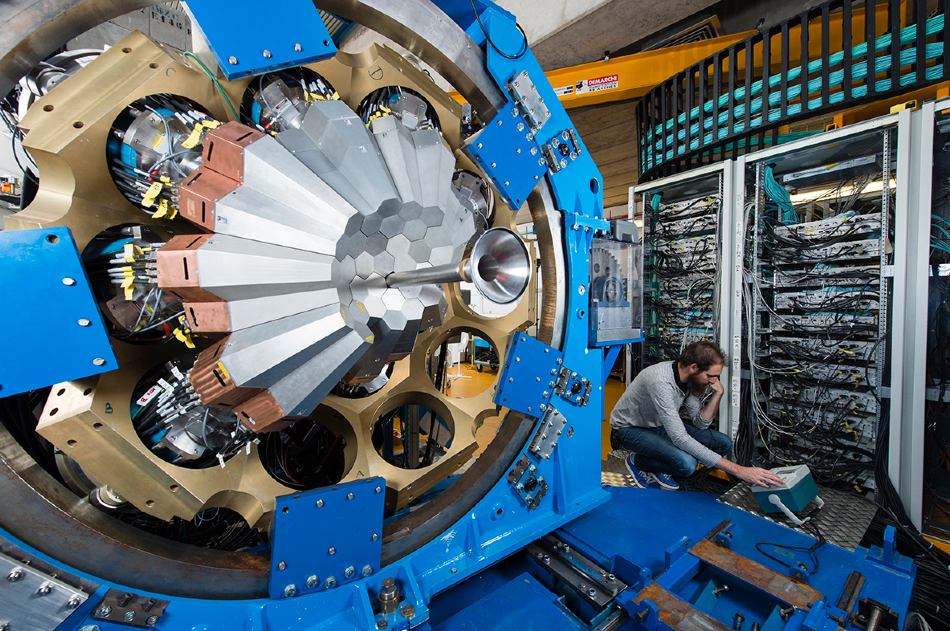Feb 18 2020
Researchers recently visualized the internal structure of ruthenium-88, a rare isotope. This observation throws new light on the internal structure of atomic nuclei, a milestone that could offer a better understanding of the formation of certain chemical elements in nature and their isotopes.
 The Advanced Gamma Tracking Array (AGATA), which researchers from KTH used to study unstable atomic nuclei generated at the Grand Accélérateur National d’Ions Lourds. Image Credit: KTH Royal Institute of Technology.
The Advanced Gamma Tracking Array (AGATA), which researchers from KTH used to study unstable atomic nuclei generated at the Grand Accélérateur National d’Ions Lourds. Image Credit: KTH Royal Institute of Technology.
An international team of researchers led by Bo Cederwall, Professor of Experimental Nuclear Physics at KTH Royal Institute of Technology, discovered new rotational states in the highly neutron-deficient, deformed, atomic nucleus 88Ru. The study outcomes indicate that the structure of this exotic nuclear system is largely affected by the existence of strongly coupled neutron-proton pairs.
Such a structure is fundamentally different from the normal conditions observed in atomic nuclei, where neutrons and protons interact in pairs in separate systems, forming a near-superfluid state.
Bo Cederwall, Professor of Experimental Nuclear Physics, KTH Royal Institute of Technology
Cederwall added that the findings may also offer alternative explanations for the progress of the synthesis of various chemical elements, specifically their most neutron-poor isotopes, in the nucleosynthesis reactions in some stellar environments like neutron star-red giant binaries.
The findings were reported in the Physical Review Letters journal on February 12th, 2012, and are the outcome of an experiment performed at the Grand Accélérateur National d’Ions Lourds (GANIL), France, using the Advanced Gamma Tracking Array (AGATA).
Nuclear collisions were used by the researchers to develop highly unstable atomic nuclei that had equal numbers of protons and neutrons. Sensitive instruments, such as the AGATA, were used to analyze their structure by detecting the radiation emitted in the form of high-energy protons, neutrons, photons, and other particles.
The Standard Model of particle physics, which describes the elementary particles and their interactions, proposes that there are two common types of particles in nature: bosons and fermions. These particles have half-integer and integer spins, respectively.
Basic particles such as the electron and the electron neutrino are examples of fermions. Composite particles such as the neutron and the proton, as well as their fundamental building blocks, the quarks, are also examples of fermions. The basic force carriers, including the photon, the gluons, the intermediate vector bosons, and the graviton, are examples of bosons.
The properties of a system of particles vary largely based on whether it is based on bosons or fermions. On the basis of the Pauli principle of quantum mechanics, in a system of fermions (for example, an atomic nucleus), a certain quantum state can be held by only one particle at a specific point in space and time. At least one characteristic of each fermion, such as its spin, must vary for multiple fermions to exist together.
At low temperatures, systems of several fermions can present condensates of coupled particles expressed as superconductivity for charged particles (for example, electrons in a superconductor below the critical temperature), and as superfluidity for uncharged particles (for instance, the superfluid 3He). By contrast, bosons can condense separately within a limitless number of particles in the same state, called Bose-Einstein condensates.
In a majority of the atomic nuclei that fall nearer to the beta stability line and in their ground state, or excited to an energy level not very high over it, the basic structure seems to rely on pair-correlated condensates of particles having same isospin quantum number, but with opposing spins. This implies that protons and neutrons are paired isolated from each other.
Isovector pair correlations such as these lead to characteristics analogous to superconductivity and superfluidity. In the case of deformed nuclei, this structure is, for instance, expressed as discontinuities in the rotational frequency upon increasing the rotational excitation energy of the nucleus.
Discontinuities such as these, unraveled by KTH Professor emeritus Arne Johnson already in the early 1970s, have been named “backbending.” The backbending frequency is the amount of the energy needed to break a proton or neutron pair, and thus, it is also a measure of the energy discharged during the formation of a pair of nucleons in the nucleus.
For a long time, it has been theoretically predicted that there is a possibility to combine, or even replace, neutron-proton pair systems with the standard isovector pair correlations in exotic atomic nuclei that have equal numbers of neutrons and protons.
The nuclear structure that results from the isoscalar component of such pair correlations differs from what is observed in “ordinary” atomic nuclei close to stability. Among different probable experimental observations, in deformed nuclei, the backbending frequency is estimated to increase considerably than nuclei with varying numbers of protons and neutrons.
Earlier, the KTH research team visualized evidence of powerful proton-neutron correlations in 92Pd, a spherical nuclear nucleus. The results of that study were published in the Nature journal (B. Cederwall et al., Nature, volume 469, p 68–71 (2011)).
With 44 protons and 44 neutrons, the 88Ru ruthenium isotope is deformed and presents a rotation-like structure that has now been visualized up to higher spin, or rotational frequency, than what was earlier possible.
When compared to the earlier study, the new measurement offers a different angle on nuclear pair correlations. The new measurement confirms the theoretical hypotheses of a shift toward higher backbending frequency, thereby offering complementary evidence for the existence of strong isoscalar pair correlations in the heaviest nuclear systems that have protons and neutrons in equal numbers.